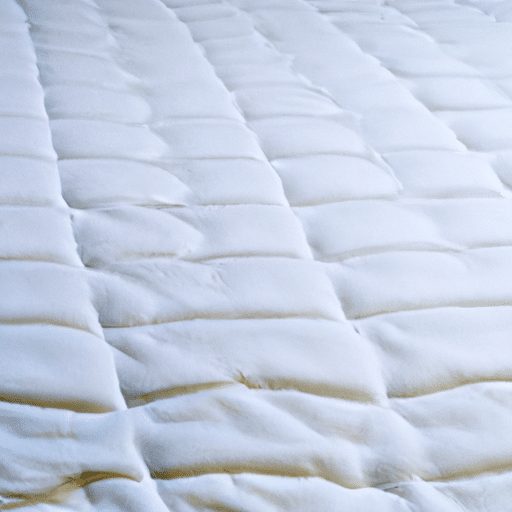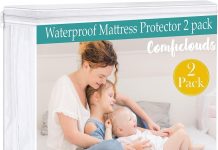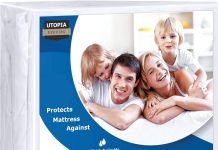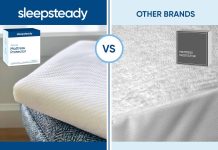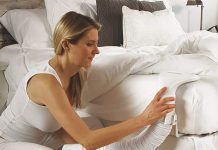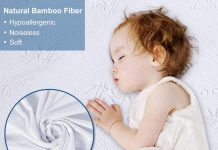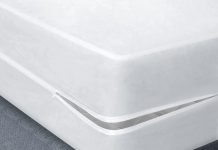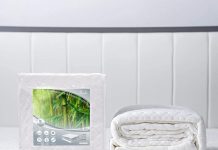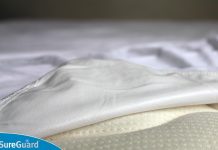Have you ever wondered about the difference between a mattress pad and a mattress protector? Well, look no further! In this article, we will explore the nuances of these two bedding essentials, and help you understand how they can enhance your sleep experience. Whether you’re looking for added comfort or improved hygiene, we’ve got you covered. So, let’s dive right in and unravel the mysteries of mattress pads and protectors!
Review contents
Definition of a Mattress Pad
A mattress pad is a cushioned layer that is placed on top of a mattress to provide additional comfort and protection. It is typically made from a variety of materials, including memory foam, down alternative, or cotton. Mattress pads are designed to fit snugly over the mattress and are secured in place with elasticized corners or straps.
Material and Construction
Mattress pads are available in different materials and construction styles. Memory foam mattress pads are made from viscoelastic foam that conforms to the body’s shape, providing excellent pressure relief and support. Down alternative mattress pads are filled with synthetic fibers that mimic the softness and loftiness of down feathers. Cotton mattress pads, on the other hand, are made from natural cotton fibers that are breathable and hypoallergenic.
Purpose
The primary purpose of a mattress pad is to enhance the comfort of the sleeping surface. By adding an extra layer of cushioning, it can help alleviate pressure points and promote a more restful night’s sleep. In addition, mattress pads also serve as a protective barrier against spills, stains, and general wear and tear, extending the life of the mattress.
Functionality
Mattress pads offer various functionalities depending on their construction and features. Some mattress pads may have cooling properties to regulate body temperature and prevent overheating during sleep, while others may be designed to provide additional support for individuals with back or joint pain. Some mattress pads also feature moisture-wicking properties to prevent the buildup of sweat and humidity, ensuring a comfortable and dry sleeping environment.
Benefits of Using a Mattress Pad
Enhanced Comfort
One of the major benefits of using a mattress pad is the enhanced comfort it provides. The extra layer of padding can help soften the firmness of a mattress, making it more comfortable for those who prefer a softer sleep surface. The cushioning effect of a mattress pad can also help alleviate pressure points on the body, reducing the likelihood of tossing and turning during the night.
Protection from Stains and Wear
Another significant benefit of using a mattress pad is the protection it offers against stains and wear. Accidental spills, sweat, and body oils can easily seep into the mattress over time, causing stains and unpleasant odors. A mattress pad acts as a barrier, preventing these substances from reaching the mattress directly. Additionally, the pad can help protect the mattress from general wear and tear, and extend its lifespan.
Temperature Regulation
Certain types of mattress pads are specifically designed to regulate body temperature during sleep. For those who tend to sleep hot, a mattress pad with cooling properties can help dissipate heat and promote a cooler sleeping environment. On the other hand, individuals who feel cold during the night can opt for a mattress pad that provides extra insulation and warmth.
Types of Mattress Pads
Memory Foam Mattress Pad
Memory foam mattress pads are constructed with viscoelastic foam, known for its contouring properties. This type of mattress pad conforms to the body’s shape, providing customized support and pressure relief. The memory foam design evenly distributes body weight, reducing pressure on the joints and promoting proper spinal alignment. Memory foam mattress pads are an excellent choice for individuals with chronic pain or those looking for added cushioning.
Down Alternative Mattress Pad
Down alternative mattress pads are made with synthetic fibers that mimic the softness and loftiness of down feathers. These pads provide a plush, luxurious feel without the potential allergenic or ethical concerns associated with real down. Down alternative mattress pads are hypoallergenic and can provide added warmth and comfort. They are an excellent choice for individuals with allergies or those who prefer a softer sleeping surface.
Cotton Mattress Pad
Cotton mattress pads are made from natural cotton fibers, providing a breathable and hypoallergenic layer. Cotton is known for its softness, moisture-wicking properties, and ability to regulate body temperature. Cotton mattress pads are comfortable, lightweight, and easy to care for. They are an ideal choice for individuals with sensitive skin or those who prioritize breathability and natural materials.
Considerations When Choosing a Mattress Pad
Thickness and Density
When choosing a mattress pad, consider the thickness and density that will best suit your sleep needs. Thicker mattress pads generally offer more cushioning and comfort, while denser pads provide better support. It is important to strike a balance between comfort and support to ensure a good night’s sleep.
Hypoallergenic Properties
If you have allergies or sensitivities, opt for a mattress pad that is hypoallergenic. Look for materials such as cotton or down alternative, which are less likely to trigger allergies. Hypoallergenic mattress pads can help reduce the accumulation of dust mites, pet dander, and other allergens, promoting a healthier sleeping environment.
Ease of Cleaning and Maintenance
Consider the ease of cleaning and maintenance when selecting a mattress pad. Some mattress pads are machine washable, while others require spot cleaning or professional laundering. Choose a mattress pad that aligns with your preferred cleaning routine to ensure convenience and longevity.
Definition of a Mattress Protector
A mattress protector is a cover that completely encases the mattress, providing a barrier against spills, stains, allergens, and bed bugs. Unlike a mattress pad, a mattress protector is usually thinner and less cushioned, with a focus on providing waterproof, allergen-proof, and bug-proof protection.
Material and Construction
Mattress protectors are available in various materials and construction styles. Vinyl mattress protectors offer waterproof and stain-resistant properties, creating a barrier against spills and accidents. Cotton terry mattress protectors feature a soft, absorbent surface that is breathable and hypoallergenic. Bamboo mattress protectors are known for their moisture-wicking and antimicrobial properties, providing protection against allergens and odors.
Purpose
The primary purpose of a mattress protector is to safeguard the mattress from spills, stains, allergens, and pests. It acts as a protective barrier, preventing liquids and stains from reaching the mattress, which could compromise its integrity and hygiene. Mattress protectors also serve as a defense against dust mites, bed bugs, and other allergens, creating a healthier sleeping environment.
Functionality
Mattress protectors offer multiple functionalities to ensure the longevity and cleanliness of the mattress. Waterproof mattress protectors prevent liquid penetration, protecting the mattress from spills, perspiration, and other moisture sources. Allergen-proof mattress protectors create a barrier against dust mites, pet dander, pollen, and other allergens, reducing the risk of allergies and respiratory issues. Additionally, mattress protectors designed to be bug-proof provide peace of mind by preventing bed bugs from infesting the mattress.
Benefits of Using a Mattress Protector
Protection from Allergens and Dust Mites
One of the significant benefits of using a mattress protector is the protection it provides against allergens and dust mites. These microscopic creatures thrive in mattresses and can trigger allergies, asthma, and other respiratory issues. A mattress protector forms a physical barrier, preventing allergens and dust mites from infiltrating the mattress and creating a healthier sleeping environment.
Defense against Bed Bugs
Bed bugs are notorious for infesting mattresses and causing sleep disruptions. Using a mattress protector with bug-proof properties can help safeguard the mattress against bed bug infestations. The tightly woven fabric and zipper closures of a mattress protector act as an effective barrier, preventing bed bugs from accessing the mattress and minimizing the risk of an infestation.
Waterproof and Stain-Resistant
Accidental spills, bedwetting, or even a pet’s mishap can lead to stains and odors on a mattress. A waterproof mattress protector can provide peace of mind by creating a barrier against liquid penetration, preventing stains and odors from seeping into the mattress. Additionally, a stain-resistant mattress protector repels spills and stains, keeping the mattress pristine and fresh for longer.
Types of Mattress Protectors
Vinyl Mattress Protector
Vinyl mattress protectors are popular for their waterproof and stain-resistant properties. They are made from a durable and flexible material that creates an impenetrable barrier against liquids and spills. Vinyl mattress protectors are often fitted with elasticized corners or zipper enclosures for a secure and snug fit.
Cotton Terry Mattress Protector
Cotton terry mattress protectors feature a soft and absorbent surface that provides waterproof protection while maintaining breathability. The cotton terry fabric wicks away moisture, ensuring a dry and comfortable sleeping environment. These protectors are often equipped with elasticized edges for easy installation and removal.
Bamboo Mattress Protector
Bamboo mattress protectors are known for their natural antimicrobial properties and moisture-wicking capabilities. The bamboo fabric is breathable, hypoallergenic, and environmentally friendly. Bamboo mattress protectors offer protection against spills, allergens, and odors, while providing a soft and comfortable sleeping surface.
Considerations When Choosing a Mattress Protector
Waterproofing Capability
When selecting a mattress protector, consider its waterproofing capability. Ensure that it provides adequate protection against spills, bedwetting, and other moisture sources. Look for features like a waterproof membrane or tightly woven fabric that effectively repels liquids.
Hypoallergenic Properties
For individuals with allergies or sensitivities, it is crucial to choose a mattress protector with hypoallergenic properties. Look for materials like cotton or bamboo, which are naturally hypoallergenic and resistant to allergens. Hypoallergenic mattress protectors can help create a healthier sleeping environment and reduce the risk of allergies and respiratory issues.
Breathability and Noise Levels
Consider the breathability and noise levels of a mattress protector before making a selection. A breathable mattress protector allows air to circulate, preventing heat buildup and humidity. This can be especially important for hot sleepers or individuals residing in warmer climates. In addition, choose a mattress protector that does not produce excessive noise when moving or shifting during sleep, ensuring a peaceful and undisturbed rest.
Comparing Mattress Pads and Protectors
Primary Function
While both mattress pads and protectors provide additional comfort and protection, their primary functions differ. Mattress pads primarily focus on enhancing comfort, providing additional cushioning and support. On the other hand, mattress protectors prioritize protection, safeguarding the mattress against spills, stains, allergens, and pests.
Material Differences
Mattress pads and protectors also differ in terms of materials used. Mattress pads are available in various materials such as memory foam, down alternative, or cotton, offering different levels of comfort and support. Mattress protectors, on the other hand, are made from materials such as vinyl, cotton terry, or bamboo, which prioritize waterproofing, stain resistance, and allergen control.
Protection Levels
In terms of protection levels, mattress protectors offer a higher degree of defense against spills, stains, allergens, and pests. The waterproof and bug-proof properties provided by mattress protectors ensure that the mattress remains clean, hygienic, and free from potential damage. While mattress pads offer some level of protection, their focus is primarily on comfort rather than full protection.
Which One to Choose?
Personal Preference and Comfort
When deciding between a mattress pad and protector, personal preference and comfort should be taken into account. If comfort is your main priority, a mattress pad would be the ideal choice. The additional cushioning and support it provides can greatly enhance your overall sleep experience. However, if protection against spills, stains, allergens, and pests is a top concern, a mattress protector would be more suitable.
Specific Needs and Concerns
Consider your specific needs and concerns when choosing between a mattress pad and protector. If you have allergies or sensitivities, a mattress protector with hypoallergenic properties would be beneficial. If you are prone to spills or accidents, a waterproof mattress protector would provide peace of mind. Assessing your individual needs will help guide you towards the most appropriate choice.
Budget Considerations
Lastly, consider your budget when making a decision. Mattress pads are generally more affordable than mattress protectors, as the latter offers more comprehensive protection features. If budget is a limiting factor, a mattress pad may be a more cost-effective option. However, investing in a high-quality mattress protector can be a wise long-term investment, as it can prolong the life of your mattress and provide added peace of mind.
Overall, whether you choose a mattress pad or protector, both can significantly enhance your sleeping experience and protect your mattress. Evaluate your priorities, preferences, and budget to make an informed decision that aligns with your specific needs. With the right bedding accessory, you can ensure a comfortable, protected, and restorative night’s sleep.

